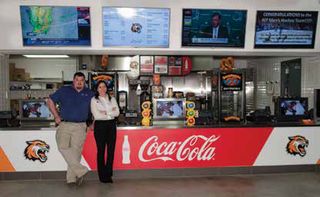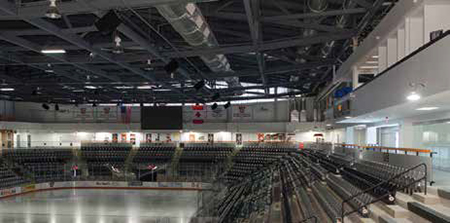The Gene Polisseni Center, the new home to RIT’s men’s and women’s hockey programs. The thrill of cheering one’s school to victory at a home sporting event is one of the hallmark experiences of American collegiate life. But how do you make this experience universally enjoyable when a significant portion of the student population is deaf?
This was a challenge the Rochester Institute of Technology (RIT) faced when designing its new ice hockey arena, the Gene Polisseni Center. RIT is home to the National Institute for the Deaf, the largest technical college in the world for students who are deaf or hard of hearing. To accommodate their special needs, a strong video presence throughout the new arena was a necessity.
RIT called on Penfield, NY-based Fusion Digital to engineer a video system with strict requirements for the 4,000-seat, 112,400-square-foot facility. The institute needed a system to control the facility’s 21 LG commercial television screens located throughout the concourse, team store, and private suites, and the system had to integrate with the in-house HD-SDI scoreboard and broadcast feeds.
After first examining the possibility of using a system made up of Cat-6 data cables and baluns, Fusion Digital’s head engineer James Marquardt proposed an equally capable and much more cost-effective alternative: a network of coaxial cables and a Contemporary Research modulation system.
“With the coax and the Contemporary Research modulators, we can add, subtract, combine, and expand basically infinitely,” Marquardt said. “It’s an older technology, but with the Contemporary Research modulator, it does what we need it to do, more cost-effectively and with higher quality than we could have done with other cable.”

James Marquardt and Alyse Ferranti of Fusion Digital stand in front of the concession stand TVs. The video integration is built around the Contemporary Research QAM modulation system, which is comprised of two QMOD-SDI modulators and 12 QMOD-YPB2 modulators for television and signage. This arrangement provided an advantage over other options when it came to live broadcasting of the games throughout the facility. “Our local Time Warner here covers the games,” said Marquardt. “So what we had to do was take that signal before it goes out to the production truck and gets broadcast to the rest of the county, and take that and broadcast it live without a delay in the building to any one of the screens, via an HD-SDI cable, and none of the other solutions were able to do that without a lot more cabling and a lot more equipment to buy.”
Equally important, this broadcast solution was able to carry closed captioning for the school’s deaf community. “The ability to have closed captioning was another thing that none of the other options—both that we had or any of the other vendors had—were able to do. So we were able to take their close-captioned feed and display it via HD-SDI.”
Of course, with almost two-dozen screens, an efficient control system is vital. Fusion Digital implemented a RS-232 control system, which also runs over the coax, to control the TVs over the wireless network from an iPad using Contemporary Research’s DX software. “When [arena staff] comes in in the morning on game day, they have one button press on the iPad and they turn everything on, and all of the TVs go to the digital signage channel,” Marquardt said. “And at the end of the night, they don’t need to run around with a remote, turning TVs off.”

JFusion Digital used Contemporary Research modulators to distribute video throughout the arena over coaxial cable.
Another bonus of the system, Marquardt pointed out, is the minimalistic approach to network connections. “Our entire system has one data connection, and being a technical school, they are very sensitive about who gets on their network,” he said. “The fact that we only have one network connection to a PC that they approved was very minimally invasive from their tech standpoint.”
According to Marquardt, the overall feedback from RIT has been tremendous. He said that the institute is so satisfied with Fusion’s work, that he and his team are permitted to walk potential clients through the facility to show them the system and explain its intricacies.
Located in a region where hockey is as popular as any sport, the RIT men’s and women’s programs now have one of the finest mid-sized arenas to draw talent and entertain the community. And with its state-of-the-art video systems, the school can be sure that its entire student body can partake in the action.
Matt Pruznick is associate editor of SCN and Residential Systems. Follow him on Twitter @Pruznick.












